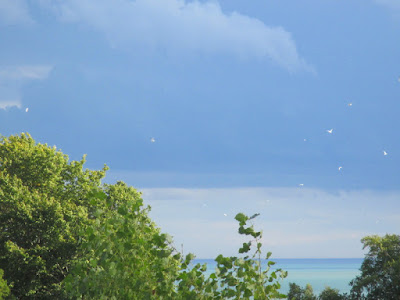During the summer I was in the garden watching the seagulls fly overhead. I thought to myself, maybe I should go and checkout where they are all heading in such a rush so I went down to the harbor lighthouse that is about 1.5 miles from the gardens.
Look at the “flock” that was there!!! Those birds are a sure sign of being near the lake. Love It!!!
Enjoy the photos and movies.
Everyday there are many that fly over the gardens.
Sometimes they rest awhile just beyond the gardens, then move on.
I went down to the harbor when I saw so many of them going past the gardens,
and here is what I found!
So Many!!!!!!!!
So Many More!!!!!!!!
A little more information about the gulls:
There are at least twenty-eight types of gull species seen in North America. These birds are fairly well distributed throughout the continent along the coastlines and at sea. Although gulls are referred to as seagulls on a daily basis by most people, they are simply referred to as "gulls" in the birding society.
The gulls are no doubt some of the hardest birds to easily identify. The plumage of the juveniles of different species takes from three to four years to achieve an adult plumage. Some of the gull types have a non-breeding and a breeding plumage that change throughout the seasons. To make this even more challenging, gulls cross-breed with other types of gulls, forming hybrids that reflect the looks and characteristics of each of the parent birds.
Originally, gulls were only scavengers of the waters on lakes, rivers or oceans on the continent. Today, these same birds compete with the crows in scavenging the city parks and food outlets. Gull species range in size from the small Little Gull with an approximate body length of 12 inches and a wingspan of 24 inches, to the large Great Black-backed Gull with an approximate body length of 30 inches and a wingspan in the area of 60 inches.







Lovely. These birds can be very noisy, but I do enjoy them.
ReplyDeleteNice to visit your site.
ReplyDeleteMariana